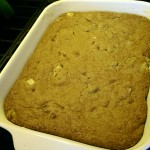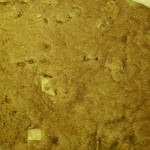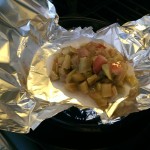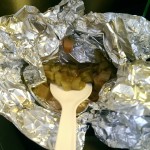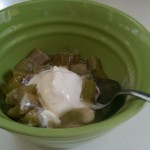March is National Nutrition Month and we’re publishing a series of blog posts that focus on nutrition within our networks. You can also learn about our programs here.
We’ve got two delicious rhubarb recipes from Vermont Fresh: A Fruit and Vegetable Handbook: Rhubarb Bites and Bake Rhubarb. We also have tips for growing, storing and cooking rhubarb.
Kate Whelley McCabe, a volunteer cooking, tasting and testing recipes out of the Vermont Fresh Handbook tested the recipes. Her comments are below in italics.
Meatless Monday Recipe: Rhubarb Bites
- Photo courtesy of Kate Whelley McCabe
- Photo courtesy of Kate Whelley McCabe
Serves 12
(adapted from www.lesleycooks.com)
Ingredients
- 2 cups rhubarb, diced (no leaves)
- ¾ cup sugar
- ½ cup butter
- 1 cup brown sugar
- 1 egg
- 1 teaspoon baking soda
- ½ teaspoon salt
- 1 teaspoon cinnamon
- 2 cups flour
- ½ teaspoon vanilla
- Confectioner’s sugar (optional)
Instructions
- Preheat oven to 350°F.
- In a medium bowl, toss rhubarb and ½ cup sugar. Set aside.
- Cream remaining sugar with butter and brown sugar.
- Beat in egg, then add baking soda, salt, cinnamon, vanilla and flour. Stir to mix.
- Stir in rhubarb mixture.
- Grease and flour a 13 inch x 9 inch baking pan. Scrape mixture into pan.
- Bake for 40-45 minutes.
- Allow to cool briefly, then sprinkle with confectioner’s sugar if desired. To serve, cut into small bars.
Good taste in 15 minutes prep and 45 minutes bake. Too moist in middle; would do 50+ minutes and use toothpick test rather than eyeball next time. I’d put cost at about $3 plus cost of Rhubarb.
Meatless Monday Recipe: Baked Rhubarb
- Photo courtesy of Kate Whelley McCabe
- Photo courtesy of Kate Whelley McCabe
- Photo courtesy of Kate Whelley McCabe
Serves 6
(adapted from www.justhungry.com)
Ingredients
- 6 cups rhubarb, diced (5-6 stalks—no leaves!)
- 1 ½ cups sugar
- 1 teaspoon vanilla extract
Instructions
- Preheat the oven to 400°F.
- Toss the rhubarb with the sugar. Drizzle with vanilla, then toss again.
- Line a baking dish with aluminum foil, leaving enough excess to double back over the top.
- Scrape the rhubarb mixture into the foil, then wrap it up in the foil to make a pouch.
- Bake until rhubarb is tender, about 30 minutes.
- Allow to cool slightly before serving. Baked rhubarb is delicious atop ice cream, stirred into yogurt, smeared onto toast, or just plain!
Great taste in 10 minutes prep plus 30 minutes bake, but just as good, quicker and even easier if you use stovetop. Cost $1 or so plus cost of Rhubarb (could not find at store in January).
Background
Although rhubarb has been used for millennia as a medicinal herb, only in the past few centuries has it come into common culinary usage. It is believed that the Chinese, who used rhubarb roots to treat illness, were the first to truly appreciate the plant. Rhubarb was exported from eastern Asia via the Silk Road to Europe, where it eventually became immensely popular. Until rhubarb started being cultivated in Europe and the Middle East, it was an extremely precious imported crop. In the Middle Ages, rhubarb was many times more expensive than other spices and even opium. The leaves of the rhubarb plant are quite poisonous–only the long stalks are suitable for culinary use. The toxicity of the leaves may explain why it took so long for rhubarb production to catch on in Europe, as early rhubarb experiments sometimes went fatally wrong for those who were not familiar with the plant’s potency. Rhubarb stems, or petioles, are very sour, so the availability of sugar may also have been related to rhubarb’s rise to popularity.
 Growing Tips
Growing Tips
The easiest way to start a rhubarb patch is to find a neighbor or friend who is overrun with rhubarb and ask to dig up a few roots early in the spring. Rhubarb leaves and stalks die back completely in the winter months, so don’t be discouraged if the roots look sad and unpromising. Dig a hole in an area with some room for the rhubarb to spread (not in the middle of your vegetable garden), add plenty of compost, and plant root clumps about 6 inches deep. Cover with more compost, water well, and wait. Rhubarb is a perennial, meaning it will come up year after year, but try to avoid the temptation to harvest stalks the first year. The plant will be stronger if allowed to grow undisturbed for one season. The second year, harvest stalks in the spring when they are about a foot tall and at least ¾ inch thick. Stalks will vary in color from crimson to green, sometimes with speckles, but are best when picked in spring regardless.
Storage
Rhubarb dries out quickly and is therefore best when used as soon as possible after picking. Always discard leaves before storing. Wrap stalks in plastic wrap and store in the crisper drawer of your refrigerator. For long-term storage, rhubarb can be frozen or made into jam.
Nutritional Benefits
Rhubarb is composed primarily of water, but it also offers some carbohydrates and dietary fiber. The stalks are rich in Vitamin K and contain significant amounts of Vitamin C and potassium as well. Remember that leaves and roots are poisonous!
Preparation
Although rhubarb is almost always cooked, raw stalks are sometimes adding as a garnish and flavoring agent to drinks such as lemonade. Fresh rhubarb stalks do not need to be peeled–simply rinsing them is all the preparation that is necessary–but larger, more fibrous stalks may be more palatable if the peel is removed. Rhubarb can be prepared in a number of ways but is most often stewed or baked into desserts.
To receive more recipes and tips on your favorite fruits and vegetables, download Vermont Fresh: A Fruit and Vegetable Handbook. We also need more volunteer home chefs for this project.
Vermont Foodbank fresh food initiatives would not be possible without your support. Please consider giving to the Vermont Foodbank today!

